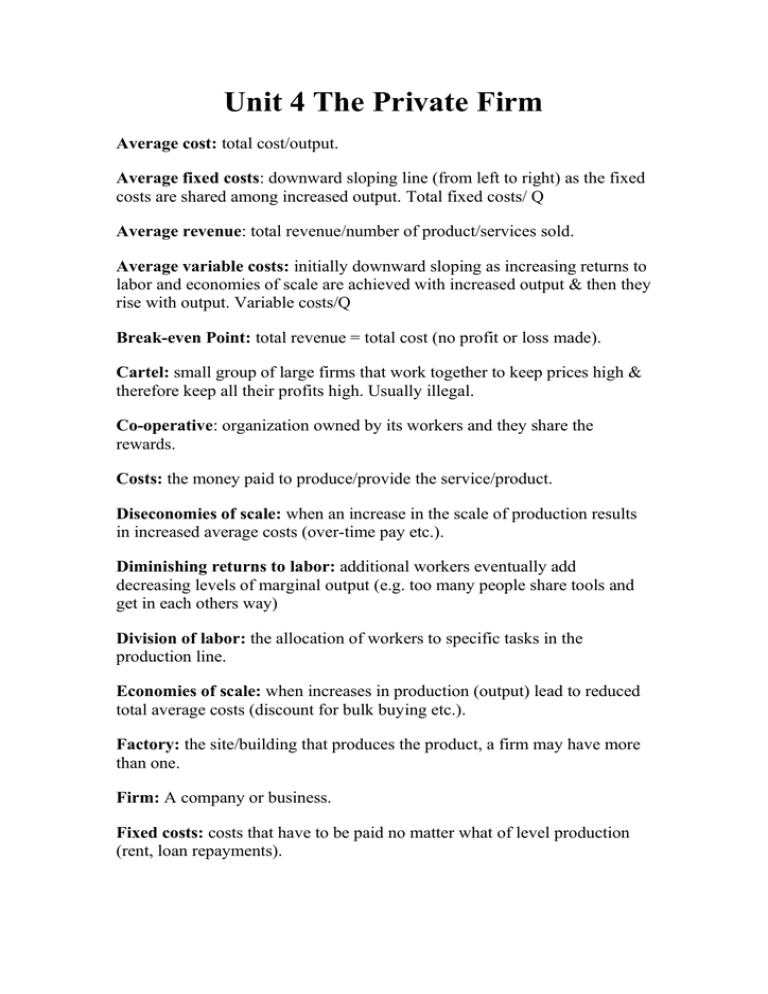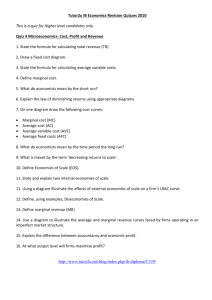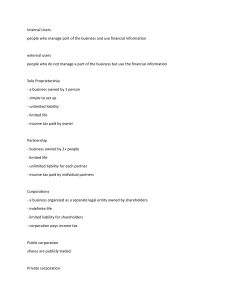Unit 4 The Private Firm
advertisement

Unit 4 The Private Firm Average cost: total cost/output. Average fixed costs: downward sloping line (from left to right) as the fixed costs are shared among increased output. Total fixed costs/ Q Average revenue: total revenue/number of product/services sold. Average variable costs: initially downward sloping as increasing returns to labor and economies of scale are achieved with increased output & then they rise with output. Variable costs/Q Break-even Point: total revenue = total cost (no profit or loss made). Cartel: small group of large firms that work together to keep prices high & therefore keep all their profits high. Usually illegal. Co-operative: organization owned by its workers and they share the rewards. Costs: the money paid to produce/provide the service/product. Diseconomies of scale: when an increase in the scale of production results in increased average costs (over-time pay etc.). Diminishing returns to labor: additional workers eventually add decreasing levels of marginal output (e.g. too many people share tools and get in each others way) Division of labor: the allocation of workers to specific tasks in the production line. Economies of scale: when increases in production (output) lead to reduced total average costs (discount for bulk buying etc.). Factory: the site/building that produces the product, a firm may have more than one. Firm: A company or business. Fixed costs: costs that have to be paid no matter what of level production (rent, loan repayments). Increasing returns to labor: initially as additional workers are employed their marginal output increases. Industry: A group of firms producing similar or same goods (e.g.: soft drinks industry - coca cola would be a firm in this industry). Marginal cost: the additional cost of producing an extra unit. Marginal revenue: the additional revenue gained from selling an extra unit. Monopoly: Single firm controls the supply in a market (has no competitors). Oligopoly: Small number of large companies controls the supply in a market. Partnership: 2 to 20 individuals jointly own a business and share the profits (solicitors). Primary Industry: Industries involved in extracting raw materials (agriculture, fishing, forestry, mining). Private Limited Company (Ltd): company owned by shareholders, but shares only sold privately, not on the stock exchange. Productivity: output per worker. Profit: revenue - costs (the money you are left over with after costs are deducted). Public Limited Company (plc): company owned by shareholders & shares sold on the stock exchange to the public. Revenue: total money obtained from sales (before any deductions). Secondary Industry: Manufacturing or construction industries. Ones that make things (factories, carpenters, bakers, builders). Sole-trader: Single owner of a business, usually small scale. Tertiary Industry: Industries that provide a service (banking, solicitors, teachers, police forces, doctors). Total costs: fixed costs + variable costs. Total Revenue: price x output (the total amount of money gained from sales of a product). Variable costs: costs that change depending on the level of production (raw materials, labor in some cases).











